Labyrinthula
A Microbial Biorealm page on the Labyrinthula
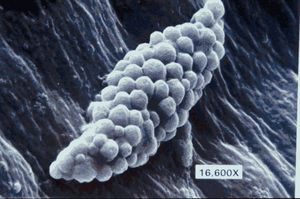
Classification
Higher order taxa:
Eukaryota; stramenopiles; Labyrinthulida
Species:
Labyrinthula zostrae
Description and Significance
Labyrinthulidae (synonym labyrinthulid) is a family of mainly marine unicellular protists, that live for the most part on sea grasses and marine algae. With their hosts they harbor a parasitic, commensalistic, or mutualistic relationship. Using an organelle called a bothrosome, labyrinthulids secrete an ectoplasmic membrane, which in turn produces a network of filaments, along which cells move and absorb nutrients. These filaments are reminiscent of a net, and give labyrinthulids their common name of slime nets. The labyrinthulids are characterized by tubulocristae mitochondria. Members of the order Labyrinthulida were originally placed in the slime mould category, but their genetics demonstrate their relation to the stramenopiles. Their classification remains a puzzle to scientists today, as does their exact role in the marine ecosystem, but some genera are being investigated more closely because of their role in the destruction of certain seagrasses.
Genome Structure
For NCBI's information on the labyrinthulids' genetics, click here.
Cell Structure and Metabolism
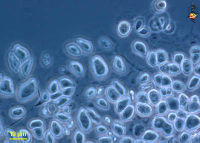
Labyrinthulids have a unique organelle called a bothrosome which produces the organism's characteristic ectoplasmic "net" of filaments. The labyrinthulids' spindle-shaped, trophic cells glide along these filaments, absorbing nutrients as they go. See Washington State University's General Mycology course website for slides and diagrams detailing labyrinthulids' cells and lice/reproductive cycles.
Ecology
Labyrinthulids are currently being studied in regards to their negative impact on several aquatic plants, especially eelgrass in North America and Europe in the mid-20th century. More recent and more surprising, however, is the sudden appearance of labyrinthulids causing rapid blight disease of cool-season grasses on golf course turf. Although they have been known to inhabit some ponds and pools with a higher-than-average salinity, terrestrial forms of the disease previously had been extremely rare.
Some examples of the damage inflicted on golf course turf when infected with rapid blight disease of cool-season grasses.
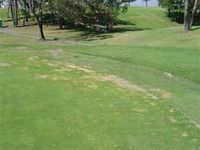
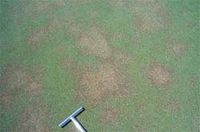
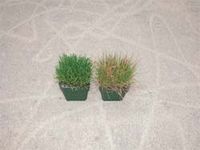
References
General Mycology . Dept. of Plant Biology, Washington State University.
Introduction to the Sagenista . Museum of Paleontology, UC-Berkeley.
"Labyrinthulomycetes." Wikipedia.
Labyrinthulomycota . Department of Plant Biology, University of Georgia.
Regan, Casie . Vampire Scientists Study Sea Grass Slime Mold in Florida Bay. National Park Service.
